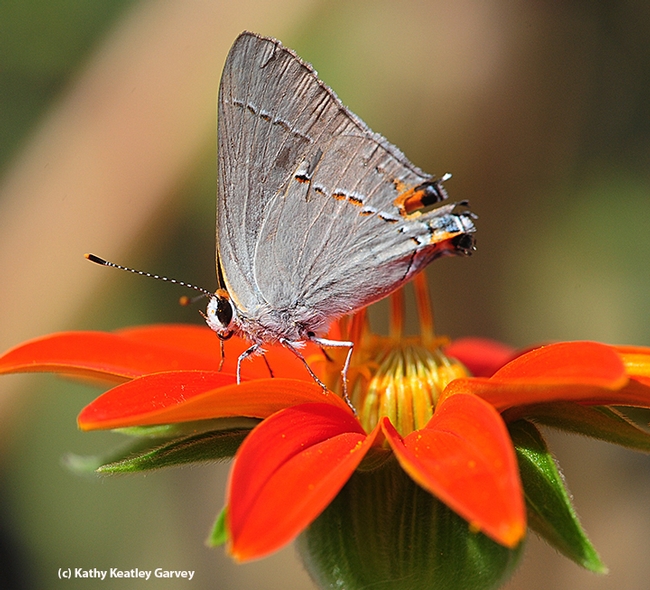- Author: Kathy Keatley Garvey

Fourteen is considered a day of love and romance, as in the 14th of February, Valentine's Day.
But at the Berkeley Aquatic Park, it's also love. Love at first sight. Or love at first site.
For the first year ever in modern history, monarch butterflies are roosting in Berkeley Aquatic Park. And they've been there since at least mid-November.
They're at the 14th hole on the disc golf course. Thousands roost there, and at any given time, dozens of butterfly aficionados and photographers gather there.
The crowd speaks in hushed tones, as if in a sanctuary.
- "There, there they are! See them? They look like dried leaves."
- "Are they all monarchs? Ooh, there goes one!"
- "Hey, everybody! It's important to plant milkweed. Monarchs lay their eggs on milkweed and that's the only plant the caterpillar will eat. If we want to keep monarchs around, plant milkweed!"
The monarchs are roosting in a shaded ash tree, next to eucalyptus and pine trees. As the sun warms them, they flutter over to the low-hanging leaves of a eucalyptus for more warmth. Just off the paved path, Canadian geese, ducks, mudhens and seagulls provide meaning to "aquatic" park.
Butterfly expert Art Shapiro, distinguished professor of evolution and ecology at the University of California, Davis, told us this morning that he's had "oodles of communication about this. None of the Bay Area butterfly people seems aware of any previous roosting there. They are also roosting at Rob Hill in the San Francisco Presidio for the first time since, I am told, 1997. Roosts that far north are often abandoned if the weather turns foul; we'll see if they persist."
Shapiro has monitored the butterfly populations of central California for more than four decades and posts research information on his website.
Elaine Miller Bond quoted Shapiro in a Nov. 23rd piece she wrote and illustrated about the Berkeley monarchs in the Berkeleyside, "Berkeley's independent news site."
Shapiro told her: “2015 has been the biggest monarch year in northern and central California in at least a decade,” says Distinguished Professor Arthur M. Shapiro from the Department of Evolution and Ecology, College of Biological Sciences at UC Davis. "And the pattern of breeding returned to the historic one seen in the 1970s-80s.”
On his website, Shapiro says this, in part, about monarchs:
"The Monarch overwinters on the central coast and moves inland, typically in early March. It moves around a great deal, so that it is unusual to see two successive generations in the same location. Females appear to avoid ovipositing on milkweeds already attacked by the oleander aphid (Aphis nerii) or the bright blue-green beetle Chrysochus cobaltinus. The Monarch acquires protective chemicals (cardenolides, "cardiac glycosides") from its host plants. Because different milkweeds differ greatly in their cardenolide content, Monarchs do also. Our commonest milkweeds (Asclepias fascicularis and A. speciosa) are low in cardenolides and produce innocuous butterflies; some relatively rare species, like the serpentine-endemic A. solanoana, are very nasty. The chemical defense is the basis for the famous mimicry by the Viceroy (Limenitis archippus) and other insects, but the Monarch has no mimics here. Population numbers vary greatly, probably reflecting disease; the locations where summer breeding occurs also vary greatly, and some years are mostly east of the Sierran crest. The westward migration begins as early as late July or August, but some breeding occurs well into autumn and adults continue to emerge at Sierra Valley into October. They then have a very short time to get over the mountains before the weather turns hostile. Altogether, there are three to four generations in an average year, but the mobility of the butterflies makes it difficult to pin this down."
The monarch belongs to the family Nymphalidae, also known as the brushfoot family.
"With about 6000 species worldwide, the morphological diversity within the brushfoots is immense," Shapiro writes on his website. "There have been decades of debates about how to classify the group and what traits are important and useful. For our purposes, the uniting characteristic of the brushfoots is the reduction of the front pair of legs into small, brush-like appendages that serve no real function, rather like the human appendix or tailbone. As a result, while they still have 3 pairs of legs (an insect characteristic), only two of those leg pairs are actually functional. Brushfoots are some of our largest and recognizable butterflies, including the monarch (Danaus plexippus), painted lady (Vanessa cardui), California tortoiseshell (Nymphalis californica), and mourning cloak (Nymphalis antiopa)."
Meanwhile, the monarchs, aka "brushfoots," are roosting at the 14th hole of the disc golf course in the Berkeley Aquatic Park.
How long they'll be there is anyone's guess. Did anyone say "El Nino"?
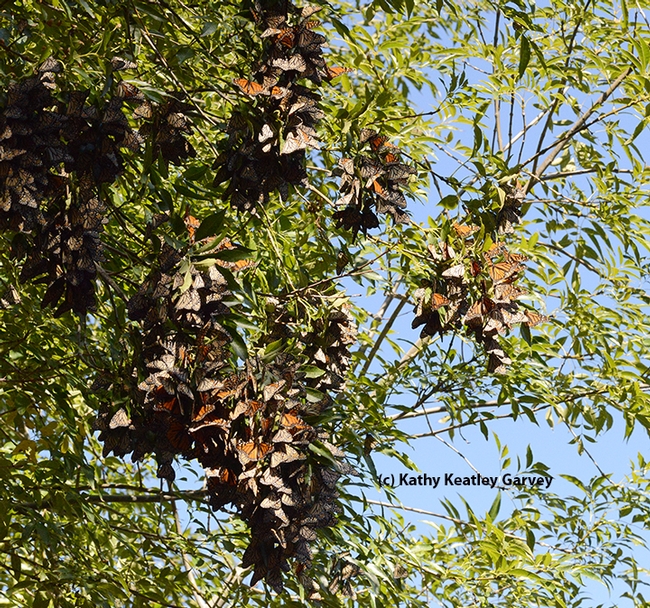
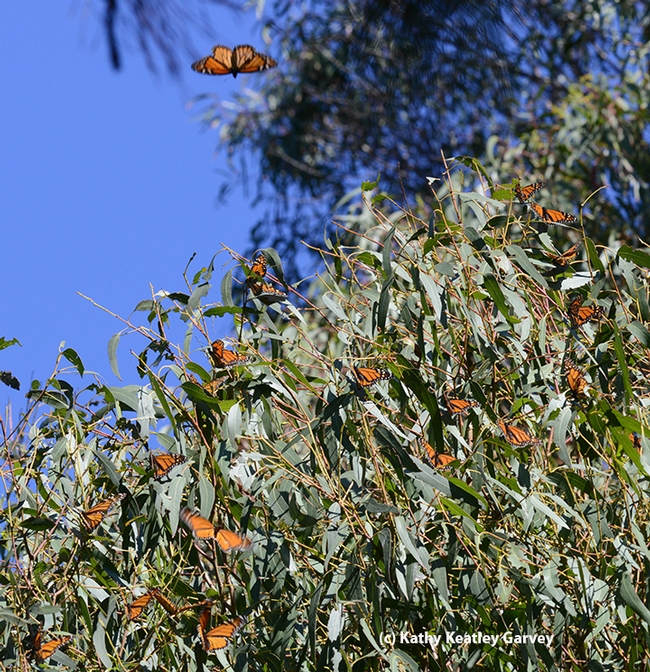
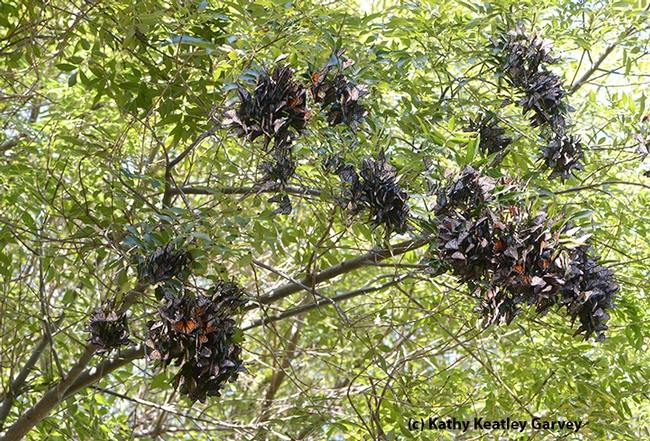
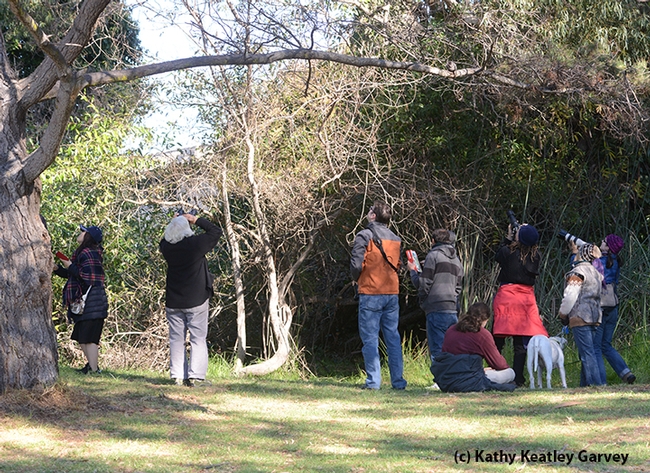

- Author: Kathy Keatley Garvey
If you look closely, you'll not only see the cycle of life in your garden, but art as the center of life.
Take the Gulf Fritillaries. They're a stunning orangish-reddish butterfly (Agraulis vanillae) with silver-spangled underwings. It's a delight seeing them laying eggs on their host plant, Passiflora (passionflower vine), watching an egg develop into caterpillar, a caterpillar form a chrysalis, and an adult eclosing.
If the light is just right, the tiny yellow egg, about the size of a period at the end of this sentence, glows. Then see,,,
- A caterpillar inching along on a passionflower vine
- An empty chrysalis or pupal case hanging like a broken chandelier.
- A male and female becoming one
Butterfly expert Art Shapiro, distinguished professor of evolution and ecology at the University of California, Davis, says this is a good year for Guld Frits. He has studied the butterflies of central California for more than four decades. Check out his research website, Art's Butterfly World.
Shapiro says the Gulf Fritillary is a long-time resident of California. It was first documented in Southern California in 1870s. "It first appeared in the vicinity of San Diego in the 1870s,” he says. “It spread through Southern California in urban settings and was first recorded in the Bay Area about 1908. It became a persistent breeding resident in the East and South Bay in the 1950s and has been there since.”
Shapiro says it “apparently bred in the Sacramento area and possibly in Davis in the 1960s, becoming extinct in the early 1970s, then recolonizing again throughout the area since 2000.”
Thank goodness for Gulf Frits!
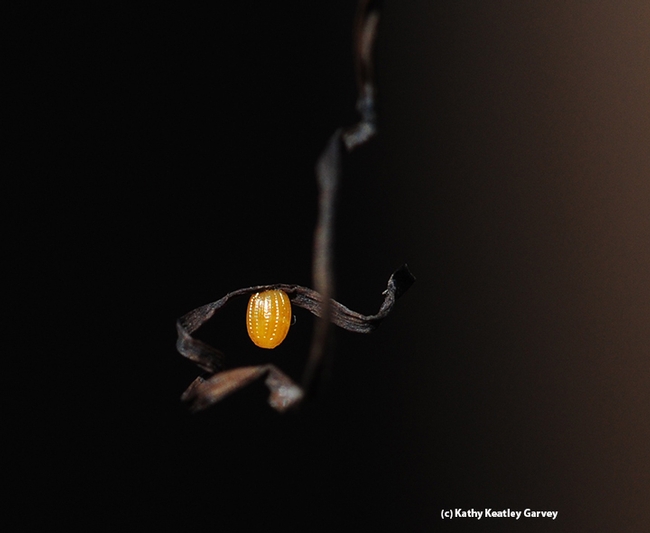


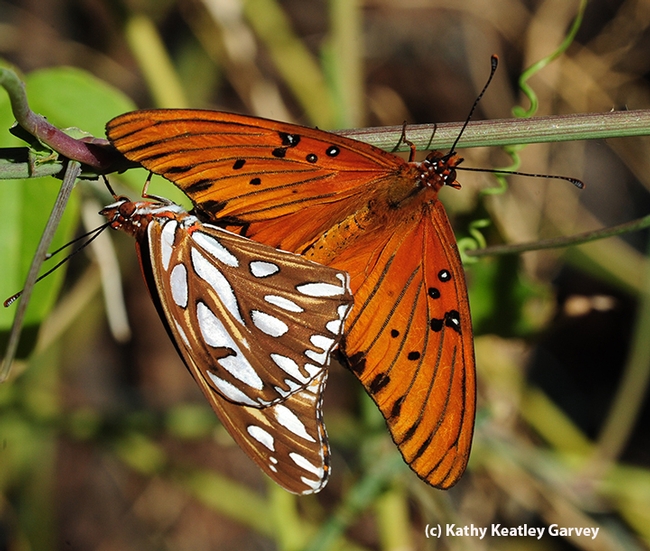
- Author: Kathy Keatley Garvey

Okay then, "What are the three primary conditions that define eusociality?"
Or how about "Nicrophorus americanus is listed under what legislative act?”
Those are just three of the questions that the UC Davis Linnaean Games Team correctly answered to win the national championship at the Entomological Society of America's annual Linnaean Games competition, held recently in Minneapolis. UC Davis defeated the University of Florida 130 to 70.
The Linnaean Games is a college-bowl type competition in which teams answer questions about insects and entomologists. The teams hold practice sessions throughout the year. So much to know, and you never know what questions will be asked! And then you have to pounce on the buzzer quickly to beat the other team to the answer!
The UC Davis team is comprised of captain Ralph Washington Jr., and members Jessica Gillung, Brendon Boudinot and Ziad Khouri. All are graduate students in the UC Davis Department of Entomology and Nematology. They earlier won the Linnaean Games competition at the regional level: the Pacific Branch of ESA.
This is the first year in ESA's 32-year history that UC Davis has won the championship.
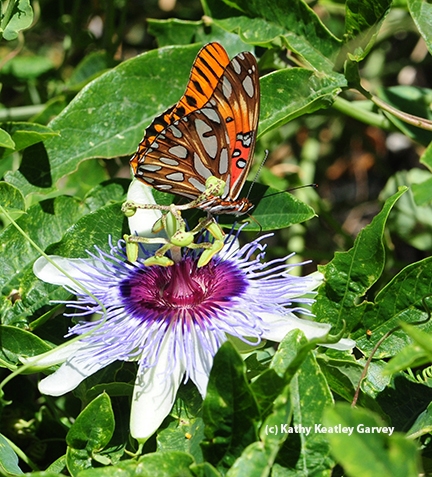
Washington is studying for his doctorate with major professors Steve Nadler and Brian Johnson, who respectively specialize in systematics and evolutionary biology of nematodes and the evolution, behavior, genetics, and health of honeybees; Boudinot with major professor Phil Ward, systematics and evolutionary biology of ants; and Jessica Gillung and Ziad Khouri with major professor Lynn Kimsey, who specializes in the biology and evolution of insects. Kimsey directs the Bohart Museum of Entomology.
Two members of the UC Davis Department of Entomology and Nematology faculty--Extension entomologist Larry Godfrey and Extension apiculturist Elina Niño--served as the team's advisors.
The questions that UC Davis correctly answered in the championship game:
Toss-Up Question: What is the smallest insect that is not a parasite or parasitoid?
Answer: Beetles in the family Ptiliidae.
Bonus Question: Some species of mosquitoes lay eggs that can undergo diapause or aestivation. Give at least three cues that trigger the aquatic eggs to hatch.
Answer: Temperature, immersion in water, concentration of ions or dissolved solutes.
Toss-Up Question: Chikungunya is an emerging vector-borne disease in the Americas. Chikungunya is derived from the African Language Makonde. What means Chikungunya in Makonde?
Answer: Bending up.
Toss-Up Question: A Gilson's gland can be found in what insect order?
Answer: Trichoptera
Toss-Up Question: Certain Chrysomelid larvae carry their feces as a defensive shield. To what subfamily do these beetles belong?
Answer: Cassidinae.
Bonus Question: The first lepidopteran sex pheromone identified was bombykol. What was the first dipteran sex pheromone identified? Give the trade or chemical name.
Answer: Muscalure, Z-9-Tricosene. It is also one of the chemicals released by bees during the waggle dance.
Toss-Up Question: What famous recessive gene was the first sex-linked mutation demonstrated in Drosophila by T.H. Morgan?
Answer: White
Bonus Question: Cecidomyiidae are known as the gall flies. What is unique about the species Mayetiola destructor, and what is its common name?
Answer: Mayetiola destructor is the Hessian Fly, a tremendous pest of wheat. It does not form galls.
Toss-Up Question: Nicrophorus americanus is listed under what legislative act?
Answer: The Endangered Species Act
Toss-Up Question: In what insect order would you find hemelytra?
Answer: The order Hemiptera.
Toss-Up Question: The subimago stage is characteristic of what insect order?
Answer: The order Ephemeroptera
Bonus Question: A 2006 Science article by Glenner et al. on the origin of insects summarized evidence that Hexapods are nothing more than land-dwelling crustaceans, which is to say that the former group Crustacea is paraphyletic with respect to the Hexapoda. What hierarchical name has been used to refer to this clade?
Answer: Pancrustacea
Toss-Up Question: What are the three primary conditions that define eusociality?
Answer: Cooperative brood care, overlapping generations, and reproductive division of labor
A total of 10 teams competed in the 2015 Linnaean Games:
Eastern Branch: Virginia Tech University and University of Maryland
North Central Branch: Michigan State University and Purdue University
Pacific Branch: UC Davis and Washington State University
Southeastern Branch: University of Georgia and University of Florida
Southwestern Branch: Oklahoma State University and Texas A&M
A YouTube video of the championship game--with all of the questions asked--will be posted soon. Last year North Carolina State University defeated the University of Florida to win the finals.


- Author: Kathy Keatley Garvey
Strange weather we're having here in Central California.
After soaring into the 90s, the temperatures pushed again into the 80s today (Oct.21). The Gulf Fritillaries (Agraulis vanillae) are "making the most-est" of their host plant, passionflower vines. Blossoms keep popping up like so much popcorn. And the Gulf Frits are there to lay their eggs all over the plant, including the tendrils, leaves, stems and blossoms.
The showy reddish-orange butterfly with the silver-spangled wings is a favorite this time of year. It's sort of like a Halloween gift before Thanksgiving.
We remember when it vanished in the Sacramento-Davis area and was even considered extinct around here in the early 1970s.
Butterfly expert Art Shapiro, distinguished professor of evolution and ecology at the University of California, Davis, sounded the alarm back then. He knows its history well.
“It first appeared in the vicinity of San Diego in the 1870s,” he told us. “It spread through Southern California in urban settings and was first recorded in the Bay Area about 1908. It became a persistent breeding resident in the East and South Bay in the 1950s and has been there since.”
Since 2000, the Gulf Frit has been recolonizing again throughout the area. Thankfully!
The butterfly lays its eggs only on passionflower vines (genus Passiflora)--lots of eggs--so expect the caterpillars to skeletonize the plant. It's a good idea to offer some nearby nectar for the adults, too. Their favorites include the butterfly bush, Mexican sunflower (Tithonia) and lantana.
Let's see, fall began Sept. 23, and winter arrives Dec. 21.
For the Gulf Frits, it might as well be spring!
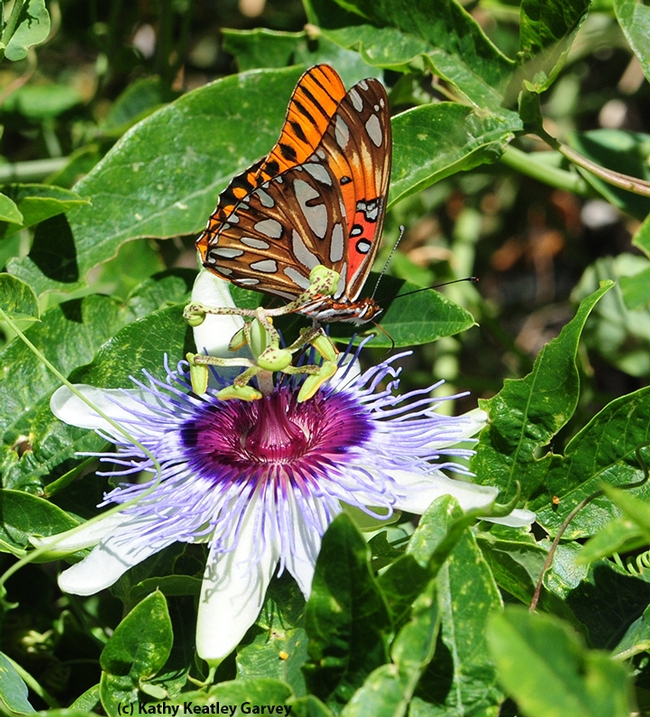

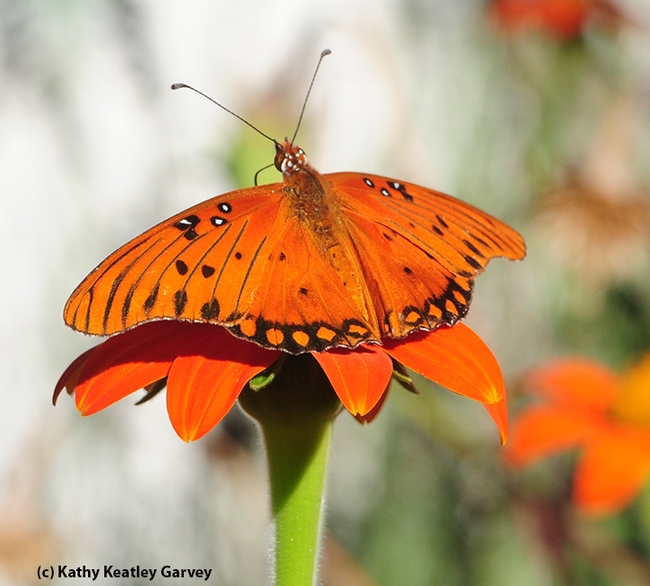
- Author: Kathy Keatley Garvey
It's delightful to see the gray hairstreak.
We're not talking about the gray streaks in our hair as we age (to perfection, of course!).
We're talking about the gray hairstreak, a common gray butterfly found throughout the United States, coast to coast, as well as parts of Canada and Mexico. Entomologists describe Strymon melinus as a small gray butterfly with a wingspan of from 2.6 to 3.65 centimeters. It is distinguished by its black-eyed orange spot at the base of its hindwing tails. It also has a small patch of blue before the tail, and two broken crossbands of black and white spots.
You may have seen it nectaring on a variety of plants. Indeed, it's considered one of the most polyphagous of butterflies. It works such flowers as sunflowers, lantana, clover, cosmos, mallows, and the like. In abundance, the larvae can become pests of cotton, peas, corn, corn, hops and other commercial agricultural crops. Cotton farmers call the larvae the "cotton square borer." The insect, however, is a pollinator more than it is a pest.
Perched on a flower with its wings up, the gray hairstreak resembles a sailboat.
It's on a winning steak. It flies fast, skillfully avoiding birds bent on a quick meal. It's a winner in other ways, too:
- it's abundant; not endangered.
- It's gray, but colorful.
- It's a flexible eater, not picky.
Read what Art Shapiro, UC Davis distinguished professor of evolution and ecology, says about the butterfly on his website.
